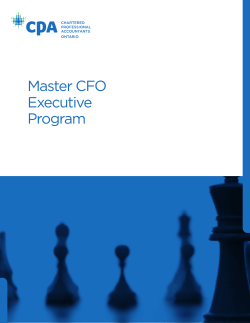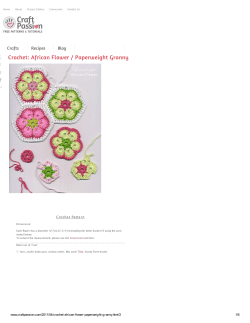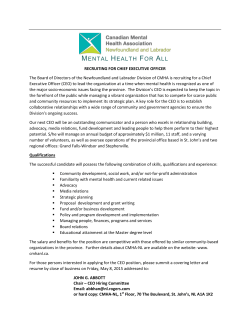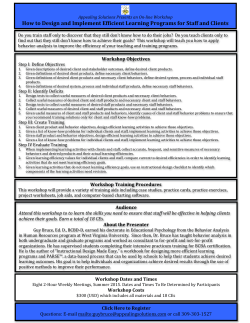
LEVELS OF CONFLICT - Congregational Development
LEVELS OF CONFLICT Based on the work of Speed Leas Introduction by Michelle Heyne & Robert Gallagher Overview This is a model developed by Speed Leas for assessing the level of conflict present in a particular situation. The model assumes that unmanaged conflict will tend to get worse and that if it does get worse, it will progress through predictable levels—perhaps with surprising speed. It also assumes that one’s ability to manage the conflict successfully (i.e., address the concerns and keep the issue from progressing to higher levels) requires accurately assessing the actual level of conflict and using strategies to address it that fit the level. Using the wrong strategy can seriously exacerbate the problem—both in using a higher-level strategy and in using a lower-level strategy than the situation calls for. For example, a corporate board has been embroiled in a dispute over the last several months concerning whether to sell the company. Significant factions have developed and the CEO is no longer talking to the CFO or EVP except in highly formal settings. The CEO has sent emails to the board reminding them of his contractual rights and noting that he has hired an attorney. Those supporting the CEO routinely use war imagery in their discussions and characterize those supporting the CFO and EVP as “traitors.” They also make professionally disparaging remarks about the competence of the CFO and EVP. There has been some significant “passive” sabotage—for example, allowing projects important to the other side to stall or go off course, and otherwise failing to share important information—but no active attempts to damage others. Those supporting the CFO and EVP are less strident. They tend not to badmouth the other side and have made some suggestions about moving forward. They mostly stick to themselves and focus on the task at hand. The tension at the company is growing. Employees are starting to look for other jobs and service is suffering. Analysis: In reviewing the criteria below, this is likely a lower Level IV conflict, or a higher Level III. It appears that the CFO’s group is at a somewhat lower level than the CEO’s. It is important to assess the conflict level at the higher group’s stage. If one influential group is at Level IV but another is at Level II, the overall system conflict needs to be managed at Level IV. The Chairman decides to hire a consultant who proposes getting everyone together to talk it out and “clear the air.” He holds a meeting with few ground rules, few shared norms, and encourages the group to talk about what’s going on. The meeting quickly degenerates into a shouting match and ends with the CFO storming out and taking half the group with him. Analysis: The consultant used a Level II strategy to address a Level IV conflict. This strategy requires relatively high trust levels and relatively low stakes. Predictably, the participants could not make use of the process provided and the situation escalated. Is it a System Conflict? For a conflict to be a system conflict (as opposed to an isolated or inter-personal conflict), a significant percentage of people, or people with significant influence, need to be upset with the practices/policies/style/person of the current leadership. In other words, just because one or two people are upset about something, it doesn’t mean that the whole organization is at a level 3 conflict—in fact, it would typically be entirely inappropriate, and even destructive, to respond to the concerns of a few as if they represented the views of a significant critical mass. At the same time, if a few significant top leaders are at Level 3 or 4, you have the makings of a system conflict. Speed Leas Levels of Conflict Model Leadership & Conflict Management An important task of leaders is to develop the organization’s capacity to solve problems and manage the “rubs” that are a normal and useful part of organizational life. This allows the organization to be a more productive and satisfying environment while also heading off serious conflict. As part of its life an organization needs to be engaged in a developmental process of building trust, developing communication and negotiating skills, and establishing processes to manage concerns and new ideas. This gives people the ability to keep conflict at the lower levels. As conflict moves to higher levels people tend to resist skill development, elaborate problem solving methods, the introduction of new ground rules, etc. So, these skills processes are best developed and implemented when the organization is not in conflict. Teach people the skills they’ll need to manage conflict when things are going well and they will be much more likely to make use of those skills when they actually need them. Skill Development Key areas to develop: Trust Development. Does the organization—at all levels—routinely demonstrate reliability, responsiveness, congruence, and reciprocity? Does the organization have regular and structured processes to share information, gather concerns, and address issues that arise—e.g., new ideas or business lines, direction and goals, implementation problems? Does the organization or team use assessments to regularly gather and share data and to assess satisfaction levels with such things as meeting structure, company climate, training and development, and resources needed to work effectively? Communication Skills. Can staff identify and communicate their feelings, thoughts and ideas? Do people take responsibility for their own feelings and thoughts while demonstrating openness and respect for those of others? Are methods employed to elicit participation and hear from everyone concerned? Decision-Making. Are decision rights understood by all? Are methods for decision-making clear in advance and generally supported? Speed Leas Levels of Conflict Model LEVEL SYMPTOMS STRATEGY LEVEL I PROBLEM TO SOLVE Objective of those involved: fix the problem Tone/behaviors: optimistic, collaborative, problem not person focus, rational; language is clear, specific, here and now, adult; real differences over goals, values, needs, plans, information; people understand each other and disagree. 1. Facilitate decision making by collaborative problem solving, or if not possible, by negotiation, or if not possible, by formal authority action (by voting or leader decision.) 2. Methods -- establish meeting norms, use a facilitator and a disciplined process, brainstorm and prioritize, use communication skills, etc. LEVEL II DISAGREEMENT Objectives: self protection, not getting hurt; solve the problem Tone/behaviors: cautious, not hostile; general language to protect people and self, e.g., “there is no trust”, “we need more openness;” hostile humor, distancing comments; withhold information that might serve the other side or damage your side. Need is to keep people close enough to work though their differences, not engage in withdrawal or begin to get aggressive. 1. Reduce tension and facilitate people’s work together. Encourage people to “hang in,” attend and prepare for meetings; coach people to act, to be assertive, help people fully express their concerns and to listen to the concerns of others; provide ways to build relationships, ways for people to know each other as people, to speak with each other about common interests and needs. 2. Methods -- role reversal, expectations clarification, paraphrase and itemized response, brainstorm and prioritize, use facilitator, etc. 2. Establish ground rules -- get agreement about how we will work on the issue, e.g., no threats, identify sources of information, direct sharing of differences, no personal attacks, no withdrawing; norms for meetings, etc. 3. Make decisions -- collaborative problem solving --- negotiation --formal authority. LEVEL III CONTEST Objective: win, not yet at level of wanting to hurt the opponent. Tone/behaviors: win/lose dynamics, threatening, difficult, resistance to peace overtures, hanging back waiting for others to show weakness, personal attacks, emotional appeals, limited social contact; language is distorted overgeneralized (“you always..”, “everyone..”), exaggerated, making a case, expecting magic or rapid change, expecting others to read your mind, extreme, only two sides, lose the shade/gray. The overall need is to reduce fear and distorted thinking; to provide a sense of order. 1. All the strategies mentioned for Level II, as possible. 2. Structure the process -- work out a clear process; dates of meetings, time lines, etc. Revise it as needed; but work at maintaining a sense of order and direction. There is a high need for a process that is seen as fair, open, and legal. 3. Use an external consultant 4. Contact between parties to the conflict needs to be carefully managed - opportunities for people to express feelings and clarify their interests need Speed Leas Levels of Conflict Model to be provided for each side; this usually needs to first be done apart from the other side; when they are ready to work together, then have a carefully facilitated meeting. 5. Decision making -- the same sequence as at other levels; however, the more persuasion, compelling and voting the more likely that people will leave the organization. LEVEL IV FIGHT/FLIGHT Objectives: hurt/get rid of the others; being “right” Tone/behaviors: factions inflexible, clear lines, strong leaders emerge; language becomes ideological - about principles, truth, rights; parties detached, causing each to lose sense of the pain they cause; attempt to enlist outsiders in the cause, parties will not speak with each other, self-righteous, cold LEVEL V INTRACTABLE SITUATION Objective: destroy the others Tone/behaviors: attempts to do serious damage to the other’s reputation, position, well being; attempts may continue after the parties have been separated More tension will require more structure. 1. Use an external consultant/mediator - this cannot be someone from the central office. 2. Follow the book -- legal issues may be involved, trust is very low; follow the organization’s standards. 3. Communicate through third parties -seek an agreement for third parties to serve as “go-betweens” to carry messages, look for possible areas of agreement, Most likely to be useful when the issue is clear. 4. Be tougher about the ground rules -enforce expectations about personal attacks, loaded language; might have a group that monitors agreements and gives feedback to violators. 5. Decision making -- likely to be by formal authority. Some are likely to leave. The conflict is no longer manageable. - Outside authority will need to make difficult decisions. - The parties need to be separated. - Some relationships will need to be terminated.
© Copyright 2025














